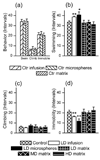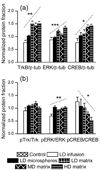The behavioral and biochemical effects of BDNF containing polymers implanted in the hippocampus of rats
- PMID: 20096671
- PMCID: PMC2834850
- DOI: 10.1016/j.brainres.2010.01.041
The behavioral and biochemical effects of BDNF containing polymers implanted in the hippocampus of rats
Abstract
Brain-derived neurotrophic factor (BDNF) is closely linked with neuronal survival and plasticity in psychiatric disorders. In this work, we engineered degradable, injectable alginate microspheres and non-degradable, implantable poly(ethylene vinyl acetate) matrices to continuously deliver BDNF to the dorsal hippocampus of rats for two days or more than a week, respectively. The antidepressant-like behavioral effects of BDNF delivery were examined in the Porsolt forced swim test. Rats were sacrificed 10days after surgery and tissue samples were analyzed by western blot. A small dose of BDNF delivered in a single infusion, or from a two-day sustained-release alginate implant, produced an antidepressant-like behavior, whereas the same dose delivered over a longer period of time to a larger tissue region did not produce antidepressant-like effects. Prolonged delivery of BDNF resulted in a dysregulation of plasticity-related functions: increased dose and duration of BDNF delivery produced increased levels of TrkB, ERK, CREB, and phosphorylated ERK, while also producing decreased phosphorylated CREB. It is evident from this work that both duration and magnitude of BDNF dosing are of critical importance in achieving functional outcome.
2010 Elsevier B.V. All rights reserved.
Figures





Similar articles
-
Antidepressant-Like Effects and Cognitive Enhancement of Coadministration of Chaihu Shugan San and Fluoxetine: Dependent on the BDNF-ERK-CREB Signaling Pathway in the Hippocampus and Frontal Cortex.Biomed Res Int. 2020 Feb 22;2020:2794263. doi: 10.1155/2020/2794263. eCollection 2020. Biomed Res Int. 2020. PMID: 32185198 Free PMC article.
-
Neuropeptide Trefoil Factor 3 Reverses Depressive-Like Behaviors by Activation of BDNF-ERK-CREB Signaling in Olfactory Bulbectomized Rats.Int J Mol Sci. 2015 Nov 30;16(12):28386-400. doi: 10.3390/ijms161226105. Int J Mol Sci. 2015. PMID: 26633367 Free PMC article.
-
Saikosaponin A improved depression-like behavior and inhibited hippocampal neuronal apoptosis after cerebral ischemia through p-CREB/BDNF pathway.Behav Brain Res. 2021 Apr 9;403:113138. doi: 10.1016/j.bbr.2021.113138. Epub 2021 Jan 22. Behav Brain Res. 2021. PMID: 33493495
-
Alginate drug delivery systems: application in context of pharmaceutical and biomedical research.Drug Dev Ind Pharm. 2014 Dec;40(12):1576-84. doi: 10.3109/03639045.2014.917657. Epub 2014 Aug 11. Drug Dev Ind Pharm. 2014. PMID: 25109399 Review.
-
Behavioral and serotonergic consequences of decreasing or increasing hippocampus brain-derived neurotrophic factor protein levels in mice.Neuropharmacology. 2008 Nov;55(6):1006-14. doi: 10.1016/j.neuropharm.2008.08.001. Epub 2008 Aug 12. Neuropharmacology. 2008. PMID: 18761360 Review.
Cited by
-
Brain-Heart Axis: Brain-Derived Neurotrophic Factor and Cardiovascular Disease-A Review of Systematic Reviews.Life (Basel). 2023 Nov 25;13(12):2252. doi: 10.3390/life13122252. Life (Basel). 2023. PMID: 38137853 Free PMC article. Review.
-
From molecular to nanotechnology strategies for delivery of neurotrophins: emphasis on brain-derived neurotrophic factor (BDNF).Pharmaceutics. 2013 Feb 8;5(1):127-67. doi: 10.3390/pharmaceutics5010127. Pharmaceutics. 2013. PMID: 24300402 Free PMC article.
-
Depression: a repair response to stress-induced neuronal microdamage that can grade into a chronic neuroinflammatory condition?Neurosci Biobehav Rev. 2011 Jan;35(3):742-64. doi: 10.1016/j.neubiorev.2010.09.010. Epub 2010 Sep 29. Neurosci Biobehav Rev. 2011. PMID: 20883718 Free PMC article. Review.
-
Nano-particle delivery of brain derived neurotrophic factor after focal cerebral ischemia reduces tissue injury and enhances behavioral recovery.Pharmacol Biochem Behav. 2016 Nov-Dec;150-151:48-56. doi: 10.1016/j.pbb.2016.09.003. Epub 2016 Sep 13. Pharmacol Biochem Behav. 2016. PMID: 27619636 Free PMC article.
-
New drug targets in depression: inflammatory, cell-mediated immune, oxidative and nitrosative stress, mitochondrial, antioxidant, and neuroprogressive pathways. And new drug candidates--Nrf2 activators and GSK-3 inhibitors.Inflammopharmacology. 2012 Jun;20(3):127-50. doi: 10.1007/s10787-011-0111-7. Epub 2012 Jan 24. Inflammopharmacology. 2012. PMID: 22271002 Review.
References
-
- Aebischer P, Schluep M, Deglon N, Joseph JM, Hirt L, Heyd B, Goddard M, Hammang JP, Zurn AD, Kato AC, Regli F, Baetge EE. Intrathecal delivery of cntf using encapsulated genetically modified xenogeneic cells in amyotrophic lateral sclerosis patients. Nat. Med. 1996;2:696–699. - PubMed
-
- Anderson KD, Alderson RF, Altar CA, DiStefano PS, Corcoran TL, Lindsay RM, Wiegand SG. Differential distribution of exogenous BDNF, NGF, and NT-3 in the brain corresponds to the relative abundance and distribution of high-affinity and low-affinity neurotrophin receptors. J. Comp. Neurol. 1995;357:296–317. - PubMed
-
- Aszmann OC, Korak KF, Kropf N, Fine E, Aebischer P, Frey M. Simultaneous GDNF and BDNF application leads to increased motoneuron survival and improved functional outcome in an experimental model for obstetric brachial plexus lesions. Plas. Reconstr. Surg. 2002;110:1066–1072. - PubMed
-
- Barras FM, Pasche P, Bouche N, Aebischer P, Zurn AD. Glial cell line-derived neurotrophic factor released by synthetic guidance channels promotes facial nerve regeneration in the rat. J. Neurosci. Res. 2002;70:746–755. - PubMed
-
- Bito H, Deisseroth K, Tsien RW. CREB phosphorylation and dephosphorylation: A Ca2+- and stimulus duration-dependent switch for hippocampal gene expression. Cell. 1996;87:1203–1214. - PubMed
Publication types
MeSH terms
Substances
Grants and funding
- R01 DA015222/DA/NIDA NIH HHS/United States
- AA017537/AA/NIAAA NIH HHS/United States
- P01 MH025642/MH/NIMH NIH HHS/United States
- (UL1-DE19586/DE/NIDCR NIH HHS/United States
- RL1 AA017537/AA/NIAAA NIH HHS/United States
- R01 DA011717/DA/NIDA NIH HHS/United States
- NS45236/NS/NINDS NIH HHS/United States
- MH025642/MH/NIMH NIH HHS/United States
- MH066172/MH/NIMH NIH HHS/United States
- UL1 DE019586/DE/NIDCR NIH HHS/United States
- T90 DK070068/DK/NIDDK NIH HHS/United States
- DA011717/DA/NIDA NIH HHS/United States
- P50 MH066172/MH/NIMH NIH HHS/United States
- R01 NS045236/NS/NINDS NIH HHS/United States
LinkOut - more resources
Full Text Sources
Other Literature Sources
Medical
Miscellaneous

